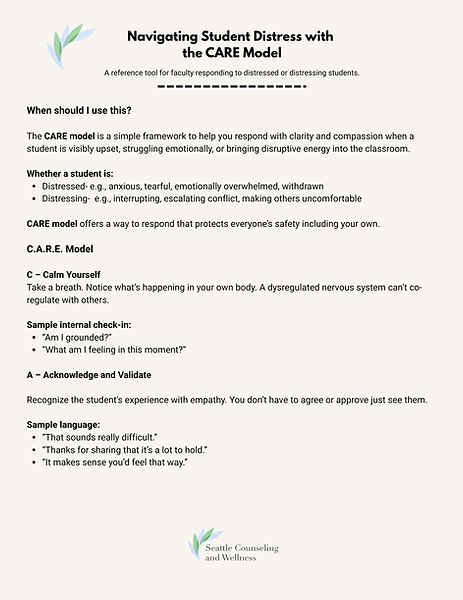Faculty & Staff Resource Library
Supporting students starts with supporting yourself. These brief, easy-to-use tools were designed for faculty and staff who want to bring more compassion, steadiness, and connection into their daily work. Each handout offers something you can try right away. Simple strategies to help you stay grounded, respond thoughtfully, and build a sense of safety and belonging in your classroom or campus community.
Compassion Tools You Can Use Tomorrow
What it is: A quick guide to simple, everyday ways to bring more compassion into your classroom or workday.
Why it helps: Small moments of care, such as taking a mindful pause, starting class with connection, or offering yourself a breath before responding can shift the tone for everyone.
Try this tomorrow: Use one tool before your next class: take a deep breath, slow your pace, and notice how that calm presence sets the tone for your students.


Navigating Student Distress with the CARE Model
What it is: A step-by-step framework for supporting students who are upset or struggling.
Why it helps: The CARE Model - Calm, Acknowledge, Respond, Engage - gives you a clear way to show empathy, de-escalate, and connect students to appropriate resources.
Try this tomorrow: When a student seems distressed, take one breath before responding. Start with Calm and Acknowledge “I can see this feels really hard right now.


Window of Tolerance: A Guide for Faculty and Staff
What it is: A simple visual and guide that explains the “window” where we can think clearly, engage, and connect.
Why it helps: Recognizing when you or a student might be outside this window, too activated or shut down, can help you use regulation skills to bring calm and focus back.
Try this tomorrow: Notice your own cues: tight shoulders, racing thoughts, or fatigue. A slow exhale or grounding moment can help widen your window and steady the room



Using a Parking Lot to Set Boundaries and Stay on Track
What it is: A classroom or meeting strategy that helps capture ideas or emotions that arise without losing focus or time.
Why it helps: The Parking Lot tool keeps discussions productive and inclusive by acknowledging what matters while maintaining structure and boundaries.
Try this tomorrow: When a discussion goes off track, say, “That’s an important point, let’s add it to the Parking Lot so we can come back to it later.”


Compassion Message Templates for Faculty
What it is: A set of short, ready-to-use messages for checking in with students, responding to struggles, setting boundaries, and maintaining connection with care.
Why it helps: When students are overwhelmed, falling behind, or emotionally vulnerable, a compassionate message can reduce shame, increase trust, and keep them engaged. These templates offer a way to respond kindly while honoring your own limits.
Try this tomorrow: Use one of the messages below to check in with a student who missed class, opened up about a challenge, or reached out while you’re stretched thin. A short, thoughtful response can be powerful.

.png)
Share Your Feedback
We hope these tools have been helpful to you!
Your feedback helps us grow and continue supporting our faculty, staff, and community partners.
Share your experience by leaving us a Google review!



